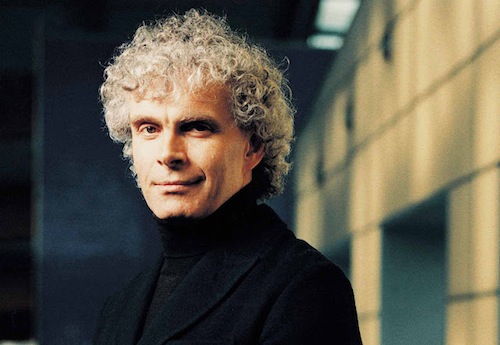Rattle, LSO electrify with a thoroughly modern Mahler Ninth

Simon Rattle led the London Symphony Orchestra in Mahler’s Ninth Friday night at David Geffen Hall.
For his “hello” to New York on Friday as the London Symphony Orchestra’s recently-appointed music director, Sir Simon Rattle led an electrifying performance of one of music’s most famous farewells.
The dry acoustics of David Geffen Hall suited the English maestro’s unsparing take on Mahler’s Ninth Symphony, a sonic x-ray of the stages of grief from rage to dread to acceptance.
Early on, the Mahler revival of the last century seemed to many like a resurgence in interest in Romanticism. But Mahler-our-contemporary now rules the interpretive roost. In Friday’s performance — especially in the passionate, chaotic first movement — the dissonance wasn’t just emancipated, it was seized upon. Those off-harmony notes that might add a touch of ironic color to a melody became the point in themselves. Harsh woodwind interjections nearly stopped the show, and violins screeched at the tops of their phrases.
Romantic-style tone blending, and even playing together, seemed far down the conductor’s list of priorities. Transparency in a complex Mahler score is a virtue, but this performance went beyond transparency to a kind of dismantling, like one of those exploded views of a jet engine. As a picture of life disintegrating, this one would be hard to beat.
Except for some tentative playing in the horns, the London musicians attacked their task with gusto and accuracy. Conductor Rattle, like the illustrator of that engine, preserved the relationship of all the parts to each other, and never dropped the thread of the movement, despite its many pauses and start-overs. Mahler was, after all, a composer, one who literally “puts together,” and this performance never lost sight of that, even in its most disjointed moments.
Mahler’s expression marking for the second movement, “rather dull and very rough,” was likely a caution not to pretty up the rustic ländler tune as if it were a Tchaikovsky waltz. But some conductors, including Rattle on Friday, seem to take that as an indication to take the dance out of it entirely.
The movement has been criticized in some quarters as overlong, and it’s easy to see why when listening to a quarter hour of unrelieved, joyless three-thumps-to-a-bar. Mahler actually liked country music, and incorporated this “unsymphonic” material in his works in spite of his critics, both out of affection and to make satirical points. Rattle’s interpretation might have benefited from not tipping its satirical hand so soon.
There were no such ambiguities about the scherzo-like Rondo-Burleske, marked “very truculent” by the composer and performed Friday with unflagging sarcastic energy. Those screechy violins, reinforced by the piercing E-flat clarinet, topped the edgy, complex orchestral sound. The effect was enhanced by the orchestra’s tight ensemble playing — the first movement’s looseness now long forgotten — and on-time delivery despite the score’s stops and starts and sudden dynamic contrasts. (If we hadn’t heard directly from Shostakovich about Mahler’s influence on him, it would have been obvious from this movement.)
For the vibrant Adagio, the violins went low instead of high, and rich instead of harsh, as they dug out the tone for their upwardly-twining, seemingly endless melody. Strings predominated in this valedictory movement, discreetly supported by brass and winds as Rattle pressed ahead to one urgent peak after another, keeping the line as sustained here as it had been fractured in the first movement.
The long, long pianissimo fade of the symphony’s closing pages was breathtakingly sustained to the last inaudible note. The audience rewarded Rattle and the orchestra with an ovation that was also long, but fortissimo. The conductor responded by rambling through the ranks of the orchestra, not just signaling individual players to stand but pulling them up himself.
Rattle and LSO continue their exploration of Mahler’s late symphonic works with tenor Stuart Skelton and baritone Christian Gerhaher in Das Lied von der Erde 3 p.m. Sunday, and Symphony No. 10 (completed by Deryck Cooke) 8 p.m. Monday, at David Geffen Hall. lcgreatperformers.org; 212-721-6500.



Posted May 07, 2018 at 2:59 pm by Martin Lewis Platt
Wondering why SO many conductors play the Deryck Cooke imaginings of a Mahler 10th? There are 9 Mahler symphonies which Mahler actually completed. Doing 3 concerts of Mahler, why oh why wouldnt Rattle do 2 of the actual completed symphonies. Sigh.